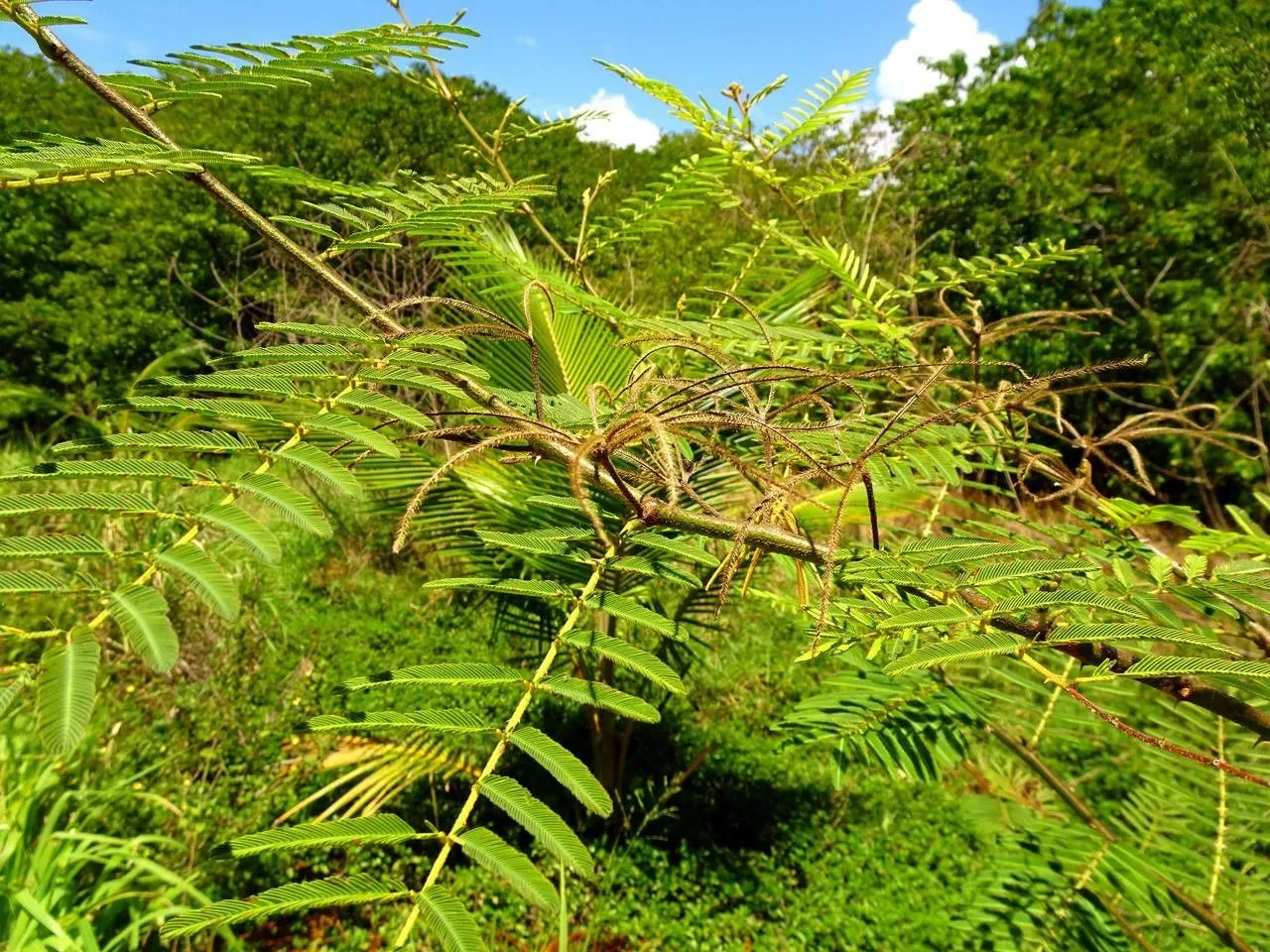
Author: L.
Bibliography: Cent. pl. I:13. 1755, nom. cons. (Amoen. acad. 4:274. 1759)
Year: 1755
Status: accepted
Rank: species
Genus: Mimosa
Vegetable: False
Observations: Trop. & Subtrop. America
The Bashfulplant, scientifically known as Mimosa pigra, belongs to the Fabaceae family. This fascinating plant is native to tropical and subtropical regions of America, where it thrives in various environmental conditions. It was first cataloged in the mid-18th century by the renowned botanist Carl Linnaeus, and its description can be found in the publication “Centuria Plantarum I,” dating to 1755, with additional notes in “Amoenitates Academicae” from 1759.
Notably, the Bashfulplant exhibits hallmark characteristics of the Mimosa genus. One of its most intriguing features is its sensitivity to touch; the leaves fold inward when disturbed, earning it the common name of Bashfulplant due to its seemingly shy behavior. This rapid plant movement is a form of thigmonasty, an adaptive response to physical stimuli that may help protect the plant from herbivorous insects and other threats.
Mimosa pigra is also of considerable ecological significance. In its native habitat, it contributes to the biodiversity and health of ecosystems, often forming dense thickets along riverbanks and floodplains. However, in non-native regions where it has been introduced, it can become invasive, outcompeting local flora and disrupting natural habitats. Consequently, it is subject to various control and management efforts to curb its spread in such environments.
The Bashfulplant’s ability to fix nitrogen through a symbiotic relationship with root-nodulating bacteria is another important trait. This not only enriches the soil, benefiting nearby plants, but also underscores its role in sustaining ecological balance.
Overall, Mimosa pigra is a plant of both intrigue and environmental importance, with its unique responsive behaviors, ecological contributions, and the challenges it presents in non-native areas.
Eng: black mimosa, bashful plant, bashfulplant, catclaw mimosa, giant mimosa, giant sensitive-plant, giant sensitive-tree, sensitive-plant, thorny sensitive plant, thorny sensitive-plant
Afr: raak-my-nie
En: Bashfulplant, Sensitive-plant, Thorny sensitive-plant, Catclaw mimosa, Giant sensitive-plant, Giant sensitive-tree, Sensitive weed, Giant sensitive plant, Black mimosa, Bashful plant, Giant mimosa, Thorny sensitive plant, Ara€a-de-gato Negro, Giant sensitive tree, Giant trembling plant, Mimosa
Af: Raak-my-nie
Ar: حباس (حَبَّاس)
Zh: 刺軸含羞草, 大含羞草
Fr: Amourette
Ff: Ganjanji
De: Mimose
Rw: Umugeyo
Pt: Columbi-da-lagoa, Juquiri, Juquiri grand, Malicia-de-boi
Pt-br: Juquiri-grande, Unha-de-gato
Sg: Kängälë
Es: Eomrmidera, Sensitiva, Espino, Una de gato, Una-de-gato, Dormilona Grande Uña de
Zh-tw: 刺軸含羞草
Th: ไมยราบยักษ์
Vi: Mai dương
© copyright of the Board of Trustees of the Royal Botanic Gardens, Kew.
© copyright of the Board of Trustees of the Royal Botanic Gardens, Kew.
© copyright of the Board of Trustees of the Royal Botanic Gardens, Kew.
Taken Aug 22, 2021 by tugdual herve (cc-by-sa)
Taken Jul 20, 2021 by Trap Hers (cc-by-sa)
Taken Jul 20, 2022 by Michal Svit (cc-by-sa)
Taken Mar 1, 2022 by Cactolandia Gardés (cc-by-sa)
Taken Mar 1, 2022 by Cactolandia Gardés (cc-by-sa)
Taken Feb 26, 2022 by Esquivel Martin (cc-by-sa)
Taken May 30, 2021 by Antoine Chourrot (cc-by-sa)
Taken Aug 3, 2019 by Frédéric Droy (cc-by-sa)
Taken Sep 10, 2021 by Aby Cantin (cc-by-sa)
Taken Feb 21, 2019 by Faiza Ahmed (cc-by-sa)
Taken Apr 12, 2014 by palustrid (cc-by-sa)
Taken Apr 12, 2014 by palustrid (cc-by-sa)
Taken Apr 12, 2014 by palustrid (cc-by-sa)
Taken Apr 12, 2014 by palustrid (cc-by-sa)
Taken Nov 7, 2013 by Thomas Delhotal (cc-by-sa)
Taken Jul 12, 2022 by Stevenazzi Fabio (cc-by-sa)
Taken Dec 13, 2020 by Jagadeeswaran Kannan (cc-by-sa)
Taken Aug 12, 2019 by Quyền Nguyễn Hùng (cc-by-sa)
Taken Apr 22, 2020 by Sébastien TRASBOT (cc-by-sa)
Taken Jan 3, 2020 by Dieter Albrecht (cc-by-sa)
Taken Jul 20, 2021 by Trap Hers (cc-by-sa)
Taken Jun 20, 2020 by RHSJ (cc-by-sa)
Taken Aug 19, 2012 by OTS – Padilla, Sergio (cc-by-nc-sa)
Taken Feb 23, 2013 by R. Tournebize (cc-by-sa)
Taken Apr 12, 2016 by Thomas Delhotal (cc-by-sa)
Taken Feb 23, 2013 by R. Tournebize (cc-by-sa)
Taken Feb 23, 2013 by R. Tournebize (cc-by-sa)
Taken Feb 23, 2013 by R. Tournebize (cc-by-sa)
Taken Apr 12, 2016 by Thomas Delhotal (cc-by-sa)
Family: Myrtaceae Author: (F.Muell.) K.D.Hill & L.A.S.Johnson Bibliography: Telopea 6: 402 (1995) Year: 1995 Status:…
Family: Rubiaceae Author: Pierre ex A.Froehner Bibliography: Notizbl. Bot. Gart. Berlin-Dahlem 1: 237 (1897) Year:…
Family: Sapindaceae Author: Koidz. Bibliography: J. Coll. Sci. Imp. Univ. Tokyo 32(1): 38 (1911) Year:…
Family: Asteraceae Author: A.Gray Bibliography: Pacif. Railr. Rep.: 107 (1857) Year: 1857 Status: accepted Rank:…
Family: Fabaceae Author: Medik. Bibliography: Vorles. Churpfälz. Phys.-Ökon. Ges. 2: 398 (1787) Year: 1787 Status:…
Family: Aspleniaceae Author: (Cav.) Alston Bibliography: Bull. Misc. Inform. Kew 1932: 309 (1932) Year: 1932…